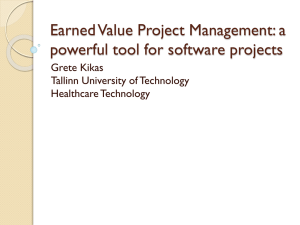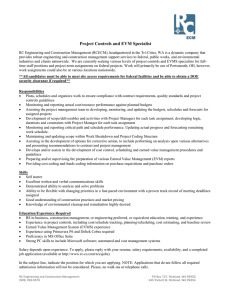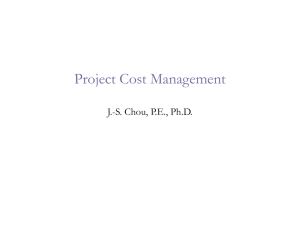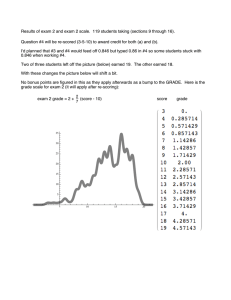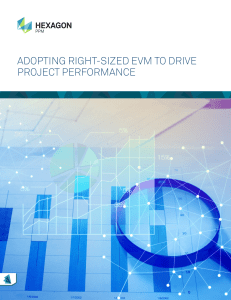Value management (VM) is a structured and analytical process that... achieve value for money by providing all necessary functions at... CHAPTER 1
advertisement
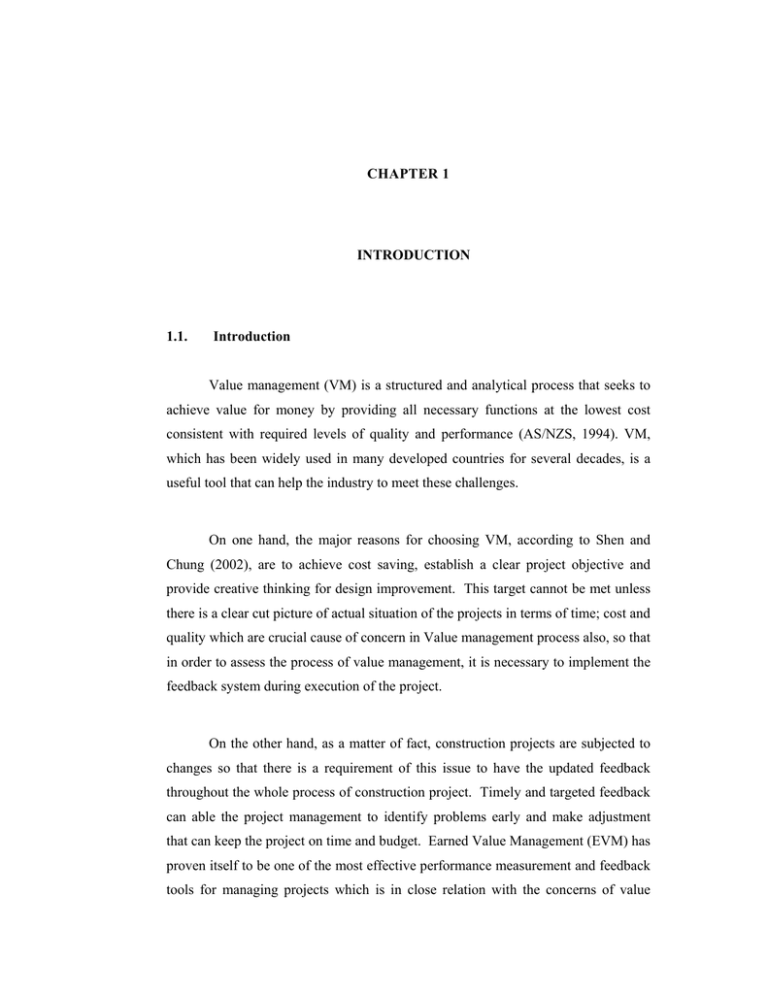
CHAPTER 1 1 1.1. INTRODUCTION Introduction Value management (VM) is a structured and analytical process that seeks to achieve value for money by providing all necessary functions at the lowest cost consistent with required levels of quality and performance (AS/NZS, 1994). VM, which has been widely used in many developed countries for several decades, is a useful tool that can help the industry to meet these challenges. On one hand, the major reasons for choosing VM, according to Shen and Chung (2002), are to achieve cost saving, establish a clear project objective and provide creative thinking for design improvement. This target cannot be met unless there is a clear cut picture of actual situation of the projects in terms of time; cost and quality which are crucial cause of concern in Value management process also, so that in order to assess the process of value management, it is necessary to implement the feedback system during execution of the project. On the other hand, as a matter of fact, construction projects are subjected to changes so that there is a requirement of this issue to have the updated feedback throughout the whole process of construction project. Timely and targeted feedback can able the project management to identify problems early and make adjustment that can keep the project on time and budget. Earned Value Management (EVM) has proven itself to be one of the most effective performance measurement and feedback tools for managing projects which is in close relation with the concerns of value 2 management system. The writer aims to develop the usage of earned value techniques in order to assess the value management system in construction projects. 1.2. Background of Study Value management (VM) is a structured and analytical process that seeks to achieve value for money by providing all necessary functions at the lowest cost consistent with required levels of quality and performance (AS/NZS, 1994). VM, which has been widely used in many developed countries for several decades, is a useful tool that can help the industry to meet these challenges. However, reluctance to use VM often stems from the time that an expensive team has to be employed to undertake the VM process (Shen and Chung, 2002). It would therefore be helpful to find a way that can make the process more efficient and effective to make the cost of undertaking VM decrease. VM has been used to improve the value of projects in government, the private sector, and the manufacturing and construction industries, and value concepts have spread worldwide. Concurrent with this growth, a number of other value improving tools, techniques, and processes emerged, many of which were complementary to and were integrated with the value concepts (SAVE International, 2007). The first use of VM in the construction industry occurred in the Navy Facilities Engineering Command in the USA in 1963 (Dell’Isola, 1982). The application of this technique in the construction industry expanded quickly as it became a mandatory requirement in many public projects in USA. In particular, the required inclusion of VM in the work scope of construction management services further drove the application of VM in this industry. After VM entered the construction industry, approaches have been developed by the combined effort of academic research and practitioners in order to fit the unique characteristics of the industry. 3 According to Kelly et al. (1992), in a comprehensive review of briefing studies for construction, the major weaknesses of the current briefing guides were too general and implicit to offer real assistance to clients and designers. These guides show what should be done without explaining how things can be done. They concluded by suggesting the use of Value Management (VM) for the future development of the briefing guide. The major reasons for choosing VM, according to Shen and Chung (2002), are to achieve cost saving, establish a clear project objective and provide creative thinking for design improvement. Internationally, VM has been recognized as an emerging paradigm that focuses on continuously increasing the value provided to the client and is widely accepted as an important tool in recent management of construction projects. The construction industry is an important field for VM at the international level VM is also critical to the success of projects as it provides a basis for improving value for money in construction. It also focuses on value rather than cost and seeks to achieve an optimal balance between time, cost and quality as it provides a method of integration in the building process that no other management structure in construction can provide. Hence, the functional requirements and seeks overall optimization were explored accordingly (Shen 1995). This was later endorsed by Liu (2003) who emphasizes the importance of VM practice to the construction industry, as it has proven to provide significant benefits to clients if it is used correctly. As Malaysia progresses towards a developed nation status, the contribution of the construction industry in Malaysia towards the development process is of paramount importance. It is in this context that VM can be considered valuable as its application can lead to significant saving leading to better value and better functional completed construction projects. Although VM was first introduced to the Malaysian construction industry in 1986 (Jaapar & Torrance 2005) it has not yet become widely practiced in the Malaysian construction industry. However, a number of successful applications of VM in the Malaysian construction industry 4 (Hussein 1998; Che Mat 1999; Karim 1999; Jaapar 2000; Sulaiman 2000; Che Mat 2002; Abdul Ghani 2002, Shamsuddin 2002; Tamim 2002; Sareh 2003; Yahya 2003; Jaapar & Torrance 2005, Che Mat 2006), calls for greater intervention and for positive steps to be taken to fully exploit VM in the industry. Earned Value Management (EVM) is a systematic approach to the integration and measurement of cost, schedule, and technical (scope) accomplishments on a project or task. It provides both the client and contractors the ability to examine detailed schedule information, critical program and technical milestones, and cost data. It takes into account the work complete, the time taken and the costs incurred to complete the project and it helps to evaluate and control project risk by measuring project progress in monetary terms. A major construction project usually spans for years, effective time and cost tracking is important to successful project delivery. Preventive and corrective actions are required to tackle any adverse situations in time. Though previous research pointed out that EVM could be successfully applied and beneficial to the industry (Christensen 1993, 1998), its effective applications in construction have been limited. Previous research (Eldin 1989; Vargas 2003; Solomon and Young 2007; Lukes 2008; Kim and Reinschmidt 2010) found that the EVM techniques fail to obtain accurate indicators to reflect project performance status, especially when the scope, schedule and cost estimates are imprecise or subjected to changes. Thus, EVM techniques are difficult to be applied to dynamic construction projects and do not add much value to project execution, especially when (1) the construction schedule is compounded by considering the resource constraints such as: resource availability limits and multiple calendars; and (2) activity and project delays encountered during project executions. Earned Value (EV) is a snapshot of work progress at a given point in time. Also known as the Budgeted Cost of Work Performed (BCWP), it reflects the amount of work that has actually been accomplished to date (or in a given time period), expressed as the planned value for that work. 5 1.3. Statement of the problem Even though there are numerous studies have been undertaken towards value management, only few concepts are available in order to measure the actual situation and predict the future value performance of the construction projects. Furthermore, the value management framework should be clarified and modified to be used in construction projects. To make the concept of value management in the line with the objectives sets by the executing and functional project managers, there is need of using tool which can satisfy the objectives of both value management system and executing managers in construction industry. In order to do so, the research writer aims at objectives which are mentioned herewith and fortunately after deploying the project all of these objectives have been met. 1.4. Aims and objectives of Study This project aims at refining the framework of value management system and introducing earned value management as a tool for measuring the performance of value management system. The main objectives of this research are as follow: 1) To perform the deep literature reviews on value management system in order to seek the different aspect and concept of value management framework. 2) To evaluate and identify important KPIs which are in line with the objectives of refined framework. 3) To introduce the earned value as a practical tool for monitor the performance of value management process through computerized approach by using Excel software. 6 1.5. Scope of Study The scope of this study is targeting the construction projects which are dealing with several difficulties regarding controlling the time and cost only leading to performance of the project. The research writer’s aim is to include the earn value in the framework of value management performance for managing the project. 1.6. Research Design In order to meet the above mentioned objectives, the writer proposes to carry out the following methodology depicted in the flow diagram of Figure 1.1: Performing a broad state of the art to understand the multiple aspects of value management through the construction of a value management process framework. Identifying the most suitable and important KPIs in accordance with the elicited framework to conducting a comprehensive questionnaire survey. Introducing the earned value as a tool for monitoring the performance in construction projects. Computerizing and automating earned value by using Excel software. 7 Fiigure 1.1 Research Design Floow Diagram m
